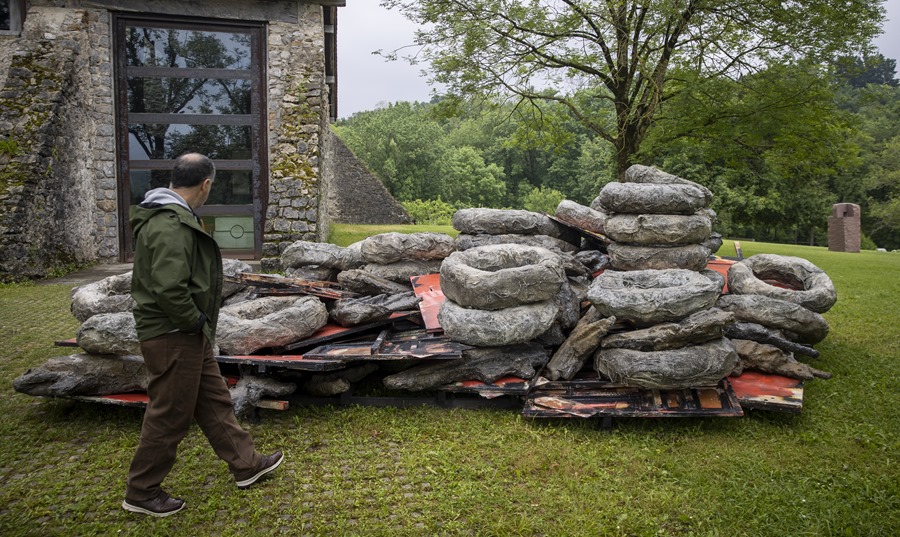Hernani (Gipuzkoa) (EFE).- Phyllida Barlow visited Chillida Leku in November to prepare the exhibition that opens this Wednesday at the Basque museum. She died suddenly in March, but her works, sculptures that reveal her construction process, have also invaded the spaces of the Hernani farmhouse.
The shock of the death of the British artist -in April she would have turned 79- for those responsible for Chillida Leku gave way a month and a half later to the assembly of the pieces, some of them large, for Barlow’s first individual exhibition in Spain .
A seven-meter tower, whose iron structure is hidden under elements created with polyurethane, cotton, burlap cloth, and cement, and which is separated by only 20 centimeters from the museum’s roof, testifies to the occupation of space that the artist sought.
Phyllida Barlow, “the contrast between the rough and the delicate”
The invasion is repeated on the first floor, where the visitor can already observe from the stairs a monumental sculpture in which different materials come together, from wood and paint to adhesion plaster, polyvinyl acetate, polystyrene, polyurethane and steel.
“The contrast between the crude and the delicate is a constant in Barlow’s work,” highlighted the exhibition coordinator for Chillida Leku, Estela Solana, at the presentation of the exhibition, which will remain open until October 22.
Next to her were the director of the museum, Mireia Massagué, the person in charge of the Education and Instigation area, Nausica Sánchez, and Luis Chillida, president of the Chillida-Belzunce Foundation, who spoke of the similarities between Barlow’s work and his father with respect to “space and scale”, but not “to materiality”.
“It is not about confronting anything, but about seeing that there are different ways of working in art, different ways of seeing things”, he pointed out.
Visit Chillida Leku
Barlow enjoyed the visit to Chillida Leku in the fall and was moved by seeing the Comb of the Wind. He respected the Basque sculptor and his admiration for his work was even reflected in black on white, in a text that the Tate Modern entrusted to him in 2011 about some pieces from the collection of this London museum.
She chose “Space Modulation I”, a small iron sculpture that Chillida made in 1963. She titled her writing “In the Heat of The Moment (In the heat of the moment)”.
Those responsible for Chillida Leku did not make Barlow any specific request, only that she “could express herself and make herself known in the context of Chillida.”
What he planned is what has been put into practice, more than thirty works have been exhibited, some conceived for this exhibition, in which the sketch of an unfinished spherical piece is exhibited, as well as a series of drawings and paintings , which in some cases connect with his previous works.
“With the sketches I get an idea of what the work might look like in its final staging. When it comes to new works without connection to others, the sketches are speculative ”, says a text by Barlow that can be read on one of the information posters of the exhibition.
works abroad
Outside, next to one of the sides of the farmhouse, are the first two works in the show. One, made up of a series of pieces that, like burned tires, rest on a jumble of wooden banners and large weapons, and the other, a hemispherical tower that seems to integrate with the stone wall of the museum.
Her contemplation is the preamble to a visit that requires the involvement of the public, which she always sought.

“To welcome his sculptures now is to take another step in expanding the limits of the sculptural medium,” Massagué highlighted the British artist, whom she met at the Venice Biennale in 2017, who dedicated her entire life to art. university teaching and to which recognition came “late”.
She was going to be the first living artist to exhibit at Chillida Leku, after the exhibitions organized on Antoni Tàpies and Joan Miró.
On the occasion of this exhibition, Chillida Leku has launched its Education Lab, in which three students from the last year of the degree of the Faculty of Fine Arts of the UPV-EHU and three master’s students have participated, who have created a sculpture inspired by the work of Barlow, which can also be seen outside.






